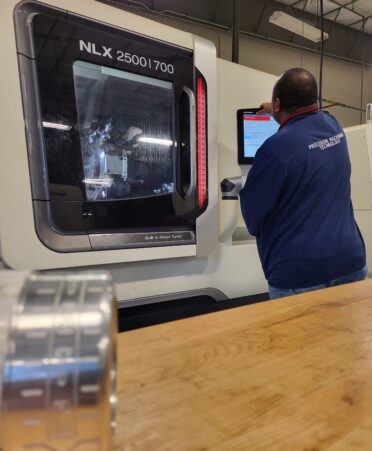(ROSENBERG, Texas) – Precision machining has become a process more and more automated since its inception. With many industries needing vast amounts of specific parts, manual machining simply cannot keep up with the demand.
As such, Texas State Technical College prepares students to face the modern challenges of the profession, training them to be the best in their field.
Almost every industry has a need for machined parts. From aviation and medical to electronics and transportation, specially designed parts are built to fulfill every need.
With such a large demand for parts, automation through the use of computer numerical control (CNC) machines is crucial. According to the Bureau of Labor Statistics, Texas alone has more than 20,000 machinists employed across the state.
If it were not for CNC machines helping to automate the machining process, the world would be very different. These machines are able to cut down to 10,000th of an inch. And they can do so every single time, without error.
Deogratias Nizigiyimana, head instructor for the Precision Machining Technology program at TSTC’s Fort Bend County campus, worked in the field for 12 years before becoming an instructor at TSTC in 2016. Since then, he has worked with students to teach them not only how to operate the manual machines, but how to program the CNC machines as well.
“I can say that now more than 90% of manufacturing companies are going to use a CNC,” Nizigiyimana stated. “The only jobs that still rely mostly on manual machines are in repair shops.”
As amazing as CNC machines are, they cannot make such precise cuts and turn out such intricate designs without a machinist programming them to do so.
CNC machines operate using one of three types of programming: manual, conversational, and computer-aided manufacturing (CAM). At the most basic level, however, the machines operate based on G-code, the mathematical operations such as spin and degree, and M-code, which handles the nonmathematical operations such as turning something on or off.
Machinists learn how to program the machines to turn out the exact part they need and then input that code into the machine. If even one line of code is off, it can mess up the end product or, worse, destroy the machine itself.
Nizigiyimana finds that throughout the Houston metro area, the biggest industries that need machinists are oil and gas. But vehicle manufacturers, robotics companies and even NASA all need machinists.
“As a machinist they (the students) can work anywhere that makes parts,” Nizigiyimana said. “There are no particular companies they have to go work for. If they can machine parts, they can be hired.”
The Fort Bend County campus has both manual and CNC machines. Students who take the program begin working with the CNC machines as early as the second semester, when they alternate between programming classes and labs. The classes and labs provide students with the knowledge and experience they will need to succeed in the Texas workforce.
The need for machinists is only going to continue to grow. Onetonline.org predicts a 23% growth rate for machinists in Texas by 2030. TSTC, through its access to state-of-the-art technology and experienced instructors, strives to help fuel that growth with educated and highly trained graduates.
For more information about TSTC, go to tstc.edu.
